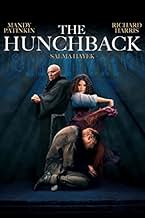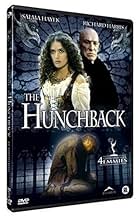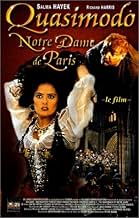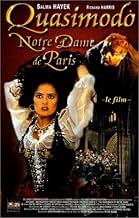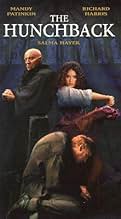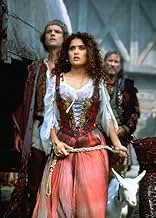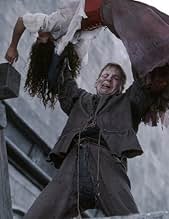IMDb-BEWERTUNG
6,1/10
1952
IHRE BEWERTUNG
Füge eine Handlung in deiner Sprache hinzuBased on the novel, a young gypsy becomes a Minister's obsession in 1483. Only the bell ringer and her husband and the court of miracles can save her.Based on the novel, a young gypsy becomes a Minister's obsession in 1483. Only the bell ringer and her husband and the court of miracles can save her.Based on the novel, a young gypsy becomes a Minister's obsession in 1483. Only the bell ringer and her husband and the court of miracles can save her.
- Für 4 Primetime Emmys nominiert
- 12 Nominierungen insgesamt
Michael Mehlmann
- Beggar
- (as Michael Mehlman)
Empfohlene Bewertungen
This version of the Victor Hugo story was good as a whole. Quasimodo wasn't particularly ugly, and it was amazing that he had read so much. Esmeralda was sweet, and it was no wonder she rejected Frollo since he looked very old and was far from attractive. However, at the beginning he really wanted to protect Quasimodo.
I was surprised that the art of printing books was so important in the film. It was incredible that Frollo was even ready to kill the King's minister rather than to let the people have books!
The public humiliation of Quasimodo and Esmeralda was shocking. It was touching that Esmeralda tried to appeal the King for the bellringer. I was very delighted that those two became friends, and again, it deeply touched me to hear Quasimodo talk about his appearance.
I had never before seen a version in which Quasimodo addressed Frollo as his father. He wanted to get him to confess his crime, but still, he tried to save him from death. And he was even strong enough to defy his guardian when he said: "You are a freak."
At the end, it was touching to see Esmeralda ring the bells for Quasimodo - at least, he was happy at the moment of his death.
I was surprised that the art of printing books was so important in the film. It was incredible that Frollo was even ready to kill the King's minister rather than to let the people have books!
The public humiliation of Quasimodo and Esmeralda was shocking. It was touching that Esmeralda tried to appeal the King for the bellringer. I was very delighted that those two became friends, and again, it deeply touched me to hear Quasimodo talk about his appearance.
I had never before seen a version in which Quasimodo addressed Frollo as his father. He wanted to get him to confess his crime, but still, he tried to save him from death. And he was even strong enough to defy his guardian when he said: "You are a freak."
At the end, it was touching to see Esmeralda ring the bells for Quasimodo - at least, he was happy at the moment of his death.
Sometimes it is difficult to judge a reproduction of an old classic film. The remake has to interpret the story to a different generation. I believe this Peter Medak movie will be better received by the younger generation for its modern visual effects and story telling. I recomend this film to high school and college students who will need to write a book report on the Hunchback of Notredame and want to enjoy a great movie at the same time. The casting and acting was great and the directing excellent.
Nicely done rendition of the classic melodrama, with Mandy Pantinkin taking a turn as Quasimodo, the bellringer of Notre Dame. Salma Hayek is marvelous as Esmeralda, with Richard Harris quite good as the wicked Monsignor Frollo, supported by a nice score by Edward Shearmur. The film stays faithful to the Victor Hugo storyline, while adding a new subtext about the new printing press' threat to the power of the Church, which adds to the story's existing political class substory and fuels the behind-the-scenes politics between Frollo and the King, within which the story of Esmeralda, Quasimodo, and the idealist Gringoire (quite competently portrayed by Edward Atterton, although both his role and that of Phoebus - a blasé Benedick Blythe - are quite abridged in this adaptation) play out. Jim Dale (reader of the Harry Potter audiobooks) is also quite notable as Clopin, King of the Thieves, whose presence throughout gives the story quite a fine dynamic. Small budget lessens the story's epic impact - and the setting resembles more of a rural farm than the center of Paris, but like most TVMs the story centers on the characters and this focus remains effective and likable. There have been many capable versions of the classic story - none of which have come close to matching the spectacle of the original silent version with Lon Chaney as Quasimodo; however this, along with the Charles Laughton version, is a worthy successor and was very nicely helmed by Peter Medak.
I know you'll see his name in the opening credits, but you might watch the entire production without remembering that Mandy Patinkin is in the movie. He's completely unrecognizable, and he masks his voice to talk like he's deaf. I'm famously good at recognizing people, but I couldn't see him inside Quasimodo at all. Well done! Quite frankly, I didn't think he had such great acting talents inside him. He was truly wonderful.
This tv version of The Hunchback of Notre Dame is very similar to the Disney version, and with good reason: Mandy was going to give voice to the character in 1996 until creative differences led him to leave the production and create a real-people version of his own. So, when you see Esmerelda's white goat, the discovery of baby Quasimodo on the church steps, and the Festival of Fools, you understand. Salma Hayek plays the tantalizing gypsy, and it's easy to see why Archbishop Frollo (played by Richard Harris) feels such temptation. This version delves pretty deep into that angle of the plot (but, then again, so does Disney), and Richard whips himself whenever he gets impure thoughts.
Like every version of this classic French story, there are some scenes that are just too sad to watch. I've never been able to make it through Quasimodo's humiliation in the town square; that's where the handy fast-forward button comes in. The rest of the movie is very good, especially as a real-people companion to the Disney classic. Jim Dale plays Clopin, and if you grew up seeing him in the Carry On films, or listening to his Broadway recording of Barnum, you'll be delighted to see him in such a fitting role.
Kiddy Warning: Obviously, you have control over your own children. However, due to violence and torture scenes, I wouldn't let my kids watch it.
This tv version of The Hunchback of Notre Dame is very similar to the Disney version, and with good reason: Mandy was going to give voice to the character in 1996 until creative differences led him to leave the production and create a real-people version of his own. So, when you see Esmerelda's white goat, the discovery of baby Quasimodo on the church steps, and the Festival of Fools, you understand. Salma Hayek plays the tantalizing gypsy, and it's easy to see why Archbishop Frollo (played by Richard Harris) feels such temptation. This version delves pretty deep into that angle of the plot (but, then again, so does Disney), and Richard whips himself whenever he gets impure thoughts.
Like every version of this classic French story, there are some scenes that are just too sad to watch. I've never been able to make it through Quasimodo's humiliation in the town square; that's where the handy fast-forward button comes in. The rest of the movie is very good, especially as a real-people companion to the Disney classic. Jim Dale plays Clopin, and if you grew up seeing him in the Carry On films, or listening to his Broadway recording of Barnum, you'll be delighted to see him in such a fitting role.
Kiddy Warning: Obviously, you have control over your own children. However, due to violence and torture scenes, I wouldn't let my kids watch it.
Salma Hayek deserved her Esmeralda.
This was the basic thought after the final credits of this not great but nice crafted film. Sure, the great job of Mandy Patinkin is the pillar of this film reminding the animation of 1996, offering the tools for Richard Harris for a dark, creepy character, impressive in each scene.
Fair atmosphere, not bad acting and the courage to offer the correct perspective, sure at level of sketch, to the masterpiece by victor Hugo.
Can be better ?
It is just decent. And this is the only important thing because, not being memorable version, it is a pleasant one.
In short, just correct .
This was the basic thought after the final credits of this not great but nice crafted film. Sure, the great job of Mandy Patinkin is the pillar of this film reminding the animation of 1996, offering the tools for Richard Harris for a dark, creepy character, impressive in each scene.
Fair atmosphere, not bad acting and the courage to offer the correct perspective, sure at level of sketch, to the masterpiece by victor Hugo.
Can be better ?
It is just decent. And this is the only important thing because, not being memorable version, it is a pleasant one.
In short, just correct .
Wusstest du schon
- WissenswertesMandy Patinkin auditioned for the role of Quasimodo in the Disney version of Der Glöckner von Notre Dame (1996). Patinkin brought his own accompanist to the audition and sang a rearranged version of a Alan Menken and Stephen Schwartz song--with Menken and Schwartz in the room! Needless to say, the audition was a disaster. He was cast as Quasimodo in this film and Tom Hulce was cast to voice Quasimodo in the Disney version.
- PatzerThe cathedral is shown as having only the north tower completed, with the south tower under construction. The story is set in 1480 by which time the cathedral had been fully built for over two centuries (completed in 1260)
- VerbindungenReferenced in The Ghost of Peter Sellers (2018)
Top-Auswahl
Melde dich zum Bewerten an und greife auf die Watchlist für personalisierte Empfehlungen zu.
Details
- Erscheinungsdatum
- Herkunftsländer
- Offizieller Standort
- Sprache
- Auch bekannt als
- The Hunchback of Notre Dame
- Drehorte
- Produktionsfirmen
- Weitere beteiligte Unternehmen bei IMDbPro anzeigen
Zu dieser Seite beitragen
Bearbeitung vorschlagen oder fehlenden Inhalt hinzufügen

Oberste Lücke
What is the English language plot outline for Der Glöckner von Notre-Dame (1997)?
Antwort


